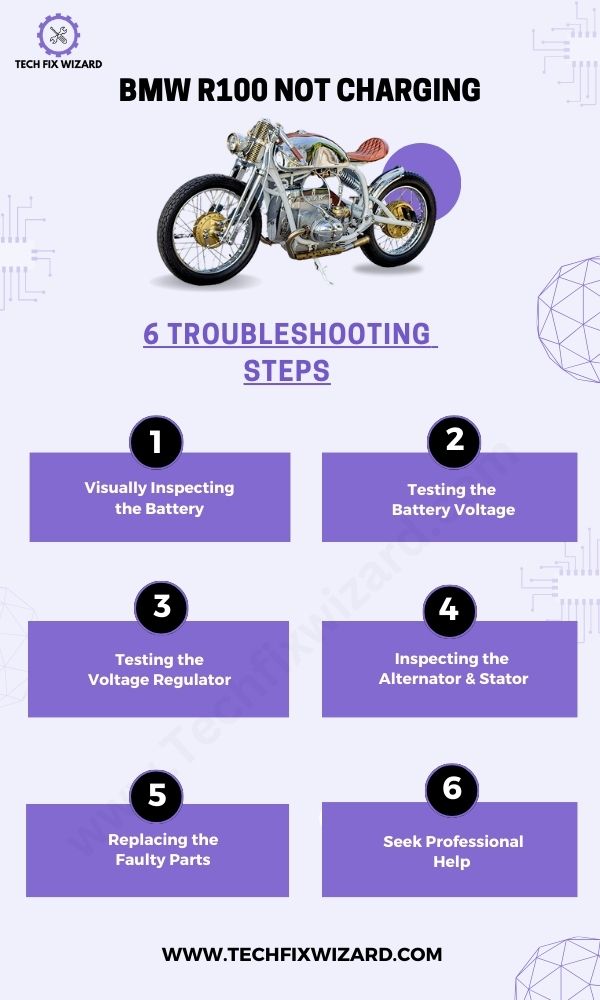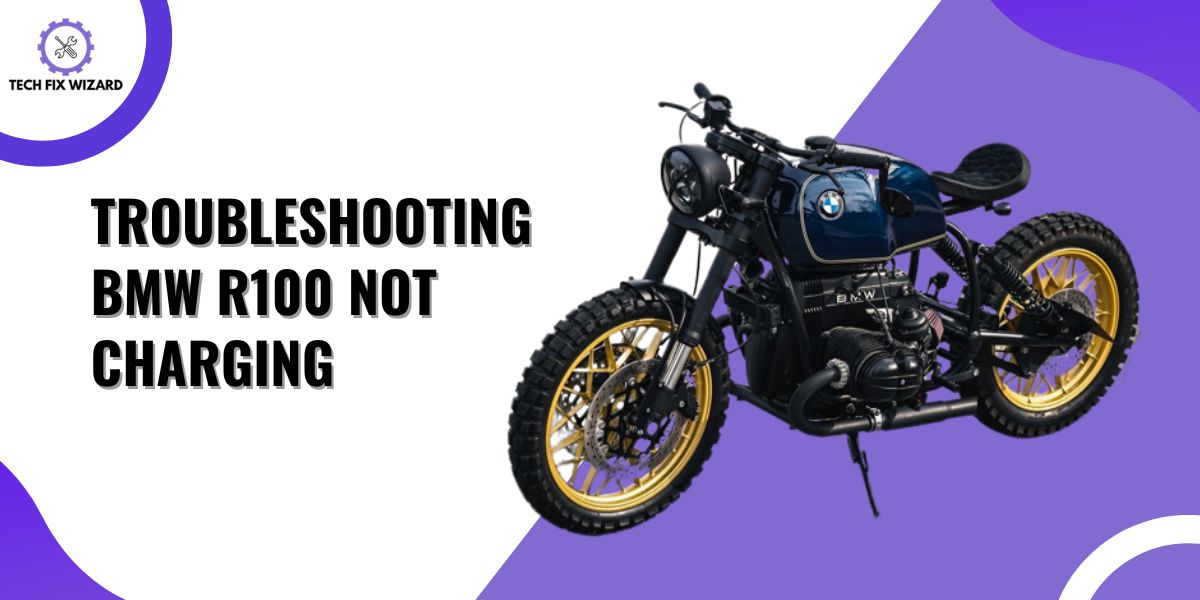If you’re a proud owner of a BMW R100 motorcycle, you know how thrilling it can be to hit the open road on this classic machine.
However, if you are experiencing the BMW R100 not charging issue, it can quickly put a damper on your riding experience.
Fortunately, there are steps you can take to fix the problem and get back to enjoying your rides.
In this article, we’ll guide you through the process of diagnosing and repairing a BMW R100 not charging issue.
So let’s get into it!
Contents
- 1 BMW R100 Not Charging – 7 Common
- 2 Symptoms
- 3 Troubleshooting BMW R100 Not Charging – 6 Easy Steps
- 4 1. Visually Inspecting the Battery
- 5 2. Testing the Voltage of the Battery
- 6 3. Testing the Voltage Regulator
- 7 4. Inspecting the Alternator and Stator
- 8 5. Replacing the Faulty Parts
- 9 6. Taking Your BMW R100 to a Professional Mechanic
- 10 FAQs
- 11 1. Why is my BMW R100 not charging the battery?
- 12 2. How can I check if the alternator is the problem?
- 13 3. What could cause the voltage regulator to fail?
- 14 4. Can a loose battery connection cause charging problems?
- 15 5. How do I test the stator on my BMW R100?
- 16 6. Can a faulty rectifier cause charging issues?
- 17 7. How often should I replace the alternator belt?
- 18 8. Is it safe to ride my BMW R100 with a charging problem?
- 19 9. Can I replace the charging system components myself?
- 20 10. Can a discharged battery be recharged and used again?
- 21 Official References & Resources
BMW R100 Not Charging – 7 Common
Symptoms
if you are experiencing a BMW R100 not charging issue, you’ll notice:
- The battery warning light illuminates or flickers.
- Dimming headlights and electrical components.
- Difficulty starting the motorcycle.
- Irregular behavior or malfunctions in the electrical system.
- Stalling or rough engine performance.
- Sudden loss of electrical power while riding.
- The battery continues to discharge even when the motorcycle is not in use.
Troubleshooting BMW R100 Not Charging – 6 Easy Steps
Troubleshooting the BMW R100 not charging issue can be a straightforward process when approached systematically.
By following the easy steps below, you can identify and resolve the problem with confidence.
1. Visually Inspecting the Battery
The first thing you need to do is to inspect your battery and connections for any signs of damage or corrosion. A faulty battery or poor connections can cause charging issues on your BMW R100 motorcycle.
First, take a look at your battery and see if there’s any visible damage or wear that could be causing the issue.
- Look for cracks, leaks, or bulges on the battery casing.
- If you notice any of these issues, it’s a clear indication that the battery needs to be replaced.
- Examine the battery terminals for corrosion. Corroded terminals can disrupt the electrical connection and prevent proper charging.
- If you find corrosion, clean the terminals using a mixture of baking soda and water or a commercial terminal cleaner.

You Might Also Like: BMW Airhead Not Charging – 6 Troubleshooting Steps To Follow
2. Testing the Voltage of the Battery
After doing a thorough visual inspection of your battery now it’s time to test its battery voltage for which you can use a voltmeter.
Follow the steps given below for testing the battery voltage:
- Turn off the motorcycle’s engine and all electrical accessories.
- Connect the voltmeter’s positive (red) probe to the battery’s positive terminal (+) and the negative (black) probe to the negative terminal (-).
- Read the voltage displayed on the voltmeter.
A fully charged 12-volt battery should read around 12.6 volts when the engine is off.
If it reads less than this amount, try charging it with a trickle charger overnight and retest in the morning. If the voltage still reads low after charging, then you may need a new battery.
3. Testing the Voltage Regulator
If you have ruled out the battery causing the BMW R100 not charging issue then next is to check the voltage regulator and ensure that it’s functioning properly.
The voltage regulator is responsible for regulating the amount of voltage that goes to your motorcycle’s battery. If the voltage regulator isn’t working, then your battery won’t get charged.
- Turn on the motorcycle and let it run for a few minutes.
- Use a multimeter to measure the voltage output from the alternator; it should be around 14 volts or so.
- Measure the voltage at the battery terminals; it should also be around 14 volts if everything is working correctly.
- Compare the two measurements; if there is a significant difference, it may indicate an issue with the voltage regulator.
- Optionally, rev up your engine and measure the voltage again to check for any changes in output.

Also Read: BMW R65 Battery Not Charging – 7 Troubleshooting Steps
4. Inspecting the Alternator and Stator
Now, Take a closer look at your alternator and stator to make sure they’re in good condition and functioning properly on your BMW R100 motorcycle.
The alternator is responsible for generating electricity while the stator converts mechanical energy into electrical energy. The stator is an integral part of the alternator.
In the setup, the alternator consists of a rotor with permanent magnets mounted on the engine crankshaft and a stator with wire coils positioned around the rotor.
If either of these components is not working correctly, it may result in an issue with your bike’s charging system.

Alternator Inspection
The following table will provide you with the steps for the alternator inspection of your BMW R100.
| Step | Action | Expected Result |
|---|---|---|
| 1. Check Wiring Connections | Inspect all wiring connections for tightness, absence of corrosion, and physical damage. | All connections are secure and free from damage or corrosion. |
| 2. Measure Voltage Output | Use a multimeter to test the voltage output of the alternator while the engine is running at idle speed. | Voltage output is around 13-14 volts. |
Stator Inspection
Now, let’s do some inspection and testing of the stator of your BMW R100.
| Step | Action | Expected Result |
|---|---|---|
| 1. Visual Inspection | Visually inspect the stator for any signs of physical damage, such as cracks or broken wires. | No physical damage or visible issues on the stator. |
| 2. Resistance Testing | Use a multimeter to measure the resistance levels between each wire pair of the stator. | Similar resistance readings between wire pairs. |
By taking proper care of both your alternator and stator you can ensure that your BMW R100 motorcycle stays charged and ready for any ride you want to take it on!
Similar Post: BMW R80 Not Charging – 9 Steps To Follow
5. Replacing the Faulty Parts
To get your BMW R100 motorcycle back on the road with a properly functioning charging system, you’ll need to replace any faulty parts that were identified during the inspection.
1. Replacing the Belt:
To replace the faulty alternator belt follow the steps below:
- Loosen the alternator mounting bolts to create enough slack to remove the old belt.
- Carefully slide the old belt off the pulleys.
- Position the new belt around the pulleys, ensuring it is properly seated in the grooves.
- Tighten the alternator mounting bolts while applying tension to the belt, ensuring the correct tension is achieved.
- Double-check the belt tension and make any necessary adjustments.
2. Replacing Faulty Voltage Regulator
If you have concluded that the faulty voltage regulator is the culprit follow the steps below to replace it:
- Disconnect the negative terminal of the battery for safety.
- Locate the voltage regulator near the alternator or on the frame.
- Remove the old voltage regulator by disconnecting the wiring and unscrewing the bolts (refer to the shop manual for specifics).
- Inspect the replacement regulator for any damage or defects.
- Install the new voltage regulator securely in place.
- Reattach all removed parts and ensure all connections are properly tightened.
- Reconnect the negative terminal of the battery.
3. Replacing the Stator
To replace the stator you can follow the steps below:
- Disconnect Battery: Start by disconnecting the motorcycle’s battery and removing the engine cover for safety.
- Access Components: Identify the location of the stator and find its mounting points on the motorcycle.
- Disconnect Stator Wires: Carefully disconnect the wires connected to the stator and any fasteners that hold it in place.
- Remove Old Stator: Gently remove the old stator from the engine, ensuring not to damage any surrounding components.
- Install New Stator: Position the new stator correctly and secure it in place using the appropriate fasteners.
- Reconnect Stator Wires: Reconnect the stator wires carefully, making sure they are connected to the correct terminals.
- Reattach Engine Cover: Securely reattach the engine cover back into its position.
- Reconnect Battery: Reconnect the motorcycle’s battery, and before closing everything up, perform tests to ensure that the new stator is functioning correctly.

6. Taking Your BMW R100 to a Professional Mechanic
Now that you’ve tried troubleshooting common problems with your BMW R100, but still can’t figure out why it’s not charging, it might be time to take it to a professional mechanic.
A mechanic who specializes in BMW motorcycles will have the expertise and tools necessary to diagnose and fix the issue. Before taking your bike in for repairs, there are a few things you should keep in mind.
- Firstly, make sure you choose a reputable mechanic who has experience working on BMW motorcycles.
- Secondly, be prepared to pay for their services – repairing electrical issues is often complex and time-consuming work.
- Lastly, don’t be afraid to ask questions or get a second opinion if something doesn’t seem right.
Popular Posts:
- BMW F800GS Battery Not Charging – 7 Steps To Try
- BMW R1200GS Not Charging – 5 Quick & Easy Steps To Follow
FAQs
1. Why is my BMW R100 not charging the battery?
There could be several reasons for this issue. Common causes include a faulty alternator, a defective voltage regulator, a broken stator, or a loose/broken connection in the charging system.
2. How can I check if the alternator is the problem?
You can perform a simple test using a multimeter. Start the engine and measure the voltage across the battery terminals. If the voltage remains close to the battery’s resting voltage (around 12.6 volts) and doesn’t increase when the engine is running,
it may indicate a problem with the alternator.
3. What could cause the voltage regulator to fail?
Voltage regulators can fail due to various factors, such as overheating, electrical spikes, or general wear and tear over time. It’s essential to address any issues with the regulator promptly to avoid damage to the battery and electrical system.
4. Can a loose battery connection cause charging problems?
Yes, loose or corroded battery terminals can interrupt the charging process. Make sure to inspect the battery connections and clean them if necessary.
5. How do I test the stator on my BMW R100?
To check the stator, you’ll need to perform a resistance test. Disconnect the stator’s connector and use a multimeter to measure the resistance between its terminals.
Refer to your motorcycle’s service manual for specific resistance values to determine if the stator is functioning correctly.
6. Can a faulty rectifier cause charging issues?
Yes, a malfunctioning rectifier can cause charging problems. It’s responsible for converting the alternating current (AC) produced by the alternator into direct current (DC) to charge the battery.
7. How often should I replace the alternator belt?
The alternator belt should be inspected regularly for signs of wear and tension. If it appears cracked, damaged, or loose, it’s advisable to replace it promptly to maintain proper charging functionality.
8. Is it safe to ride my BMW R100 with a charging problem?
Continuing to ride with a charging problem can lead to a drained battery, causing the motorcycle to stall unexpectedly.
Additionally, running the motorcycle on a dead battery for an extended period can damage other electrical components.
9. Can I replace the charging system components myself?
If you have the necessary mechanical and electrical knowledge and skills, you can attempt to replace certain charging system components like the voltage regulator or alternator.
However, if you’re unsure, it’s best to consult a qualified motorcycle mechanic.
10. Can a discharged battery be recharged and used again?
In many cases, a discharged battery can be recharged and reused if it is still in good condition. However, repeated deep discharges can shorten a battery’s lifespan, so it’s essential to identify and fix the charging issue promptly to prevent further problems.
Official References & Resources
Our research for providing accurate information about BMW involved a thorough analysis of official resources, including the official BMW website owner’s manuals, technical specifications, and relevant support forums.
Our research and data gathering involved thorough analysis of the official websites, including:

John Paul is a tech enthusiast dedicated to troubleshooting. He is passionate about fixing glitches, simplifying complexities, and empowering others in the digital realm.

